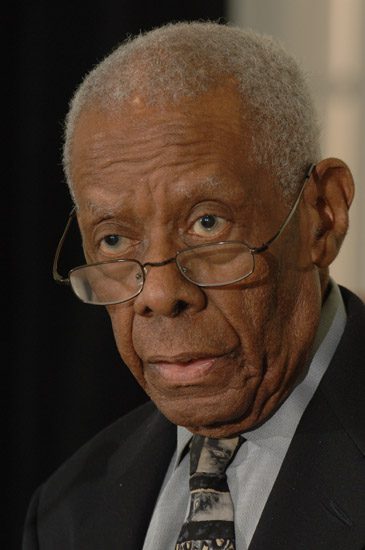|
Jesse Hill Jr. held many positions, including the first Black President of the Atlanta Chamber of Commerce, the first Black Member of the Georgia Board of Regents, and the first Black Member of the Board of Directors for Rich’s Department Store. (Nikon D2X, ISO 400, f/5.6, 1/250, Sigma 120-300mm f/2.8 with 1.4 converters)
|
When I speak to groups, someone usually asks me what camera I use. Next, someone else will ask, “Would I take better pictures if I had a better camera… maybe one like you?”
The best answer I’ve ever heard to “The Camera Question” came from Joanna Pinneo, a former colleague of mine. Joanna is an outstanding photographer who has worked for Newsweek and National Geographic. Joanna had just finished wowing an audience with some of her photographs when a little old lady asked, “If I had a camera like yours would I take better pictures?”
“Probably not,” Joanna said, “you will take the best photos with a camera that is easy for you to use. When you see something you want to photograph, the less you think about the camera, the better your picture will be.”
Joanna pointed out that professional photographers are so familiar with their cameras that using them is second nature, like driving a car. She told the little lady that unless she planned to study photography, she should find a simple and easy camera to concentrate on the subject of the photograph she wanted to take.
She was right, of course. Most of your best photographs capture a moment. But, unfortunately, you’ll miss the moment if you switch lenses, fidget with a flash, or try to remember how your camera works. By the time everything is set just right, the shot is gone, and the moment has passed.
On the other hand, if you have a point-and-shoot camera, you can (pardon this) just point-and-shoot and capture the moment. You’ll take a better picture precisely because you did NOT have a “better” camera.
Not long ago, I was photographing the keynote speaker at an event in Atlanta. Beside me was Ambassador Andrew Young with his point-and-shoot camera. He was photographing the speaker as well. Later, he showed me his shot, and it was pretty good.
This event was not the only time I’ve seen him taking pictures. I’ve worked with him on several occasions, once I asked him about his photography. He reached into his pocket and pulled out the small point-and-shoot camera. He said he always carried it with him and loved to take pictures and share them with his friends.
Then Ambassador Young laughed. He told me he even pulled it out of his pocket at his daughter’s wedding. He was officiating the wedding, but he still took a photo at the altar ceremony.
My good friend Dave Black, who shoots for Sports Illustrated, used one for a job. One of the most outstanding qualities of these point-and-shoots is they make no noise. They are so entirely that manufacturers have put a speaker in them and created a clicking noise you can turn on or off to let you know when the shutter fires.
 |
|
Pat Perez during play at the BellSouth Classic at Sugarloaf in Duluth, Georgia. (Nikon D100, ISO 100, f/5.6, 1/800, Sigma 120-300mm f/2.8 with Sigma 1.4 converter)
|
PGA rules will not allow taking a picture of a professional golfer during their back swing since the noise might distract the golfer. However, Steve Williams, Tiger Woods’s caddy, has thrown a few cameras into lakes when people have fired away during Tiger’s backswing.
When Dave Black showed the editor from Sports Illustrated photos of Phil Mickelson in his back swing at the event, you can understand why the editor started to quiver and gasp for air. Dave pulled out the little camera and made a picture or two of the editor. When the editor found that he couldn’t even hear the little quiet camera, he began to breathe normally again.
No one had any photos of golfers in their back swing before Dave, so Sports Illustrated ran the photos big made with the little point and shoot.
Today’s cameras are so much better than before. Take, for example, the point-and-shoot Nikon P80. Nikon’s enhanced Face-Priority AF automatically finds and focuses on one person or up to 12’people’swithin one frame. Face-Priority AF provides faster and sharper focus to produce detailed, crisp portraits wherever positioning the subjects in the frame. The P80 has an 18x optical zoom lens with a 27 – 486mm (35mm equivalent) focal length coverage. The maximum aperture is F2.8 to 4.5. It has 10.1 megapixels letting you capture fine detail with the creative freedom to crop and edit.
The fantastic thing is that the professional-grade Nikon camera body with all the lenses needed to match the zoom power of the little P80 would cost close to $15,000, but the P80 sells for just $399. (Hay, I’m wonI’ming if I need all this expensive photographic equipment!)
Another camera similar to the Nikon P-80 is the Panasonic Lumix DMC-FZ28K. It has a Leica lens, and the pricing is close to the Nikon P-80.
Joanna Pinneo said it so well: “You wi“l take the best photos with a camera that is easy for you to use.”
Guess” the adage is true after all. I’ll paI’llrase: It would be Stupid, not just to Keep It Simple.


